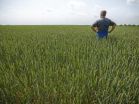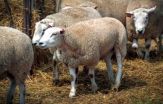(Press-News.org) As the world turns its attention to Brazil with the opening of the World Cup this month, many people around the globe know the country's soccer fame, but few realize that it is the world's leader in reducing carbon emissions. A new study published in Science magazine provides the first in-depth analysis of how Brazil reached this global-leader status and managed to increase its agriculture production at the same time.
"Brazil is known as a leading favorite to win the World Cup, but they also lead the world in mitigating climate change," says the study's lead author, Daniel Nepstad who heads the Earth Innovation Institute and is a lead author of the recent IPCC report.
Since 2004, farmers and ranchers in Brazil have spared over 86,000 square kilometers of rainforests, close to 14.3 million soccer fields, from clear-cutting. Saving these forests amounts to a 70% decline in deforestation and 3.2 billion tons of CO2 kept out of the atmosphere. The decline in deforestation in 2013 alone represented a 1.5% reduction in global emissions for that year.
In this new study, a group of 17 scientists and economists from the US and South America set out to understand what drove this change. They found that a combination of bold public policies, market rejection of deforesting farmers, and an increase in protected areas curbed clear-cutting, while still allowing the country's soy and beef production to grow.
"There is an urge to find a silver bullet hiding in all the different deforestation efforts. But the truth is that the government can't claim this win alone, nor can Greenpeace or responsible companies. It's the mixture of interventions that worked," says co-author Toby McGrath.
Brazil's success points to the potential for tropical nations to produce more food without destroying forests, but the authors warn that these wins may be short-lived without more positive incentives for farmers on the ground.
"These gains are globally significant, but fragile," explains Nepstad. "We're bumping up against the limits of what can be achieved through punitive measures. As global demand for soy and beef begins to grow again, we will need a new approach to keep deforestation low in the Amazon. Through a one billion dollar pledge from Norway, Brazil has an important first step towards the creation of positive incentives for farmers who forgo forest clearing."
From 1999-2004, pressure on Amazon rainforests increased dramatically as commodity markets drove large-scale expansion of farming for soy, allowing local economies to prosper. Forests were cut down at alarming rates, with swaths the size of Vermont cut down each year from 2002 to 2004. Though the government's forest code policy required farmers to keep 80% of their land as native forest, these rules were unrealistic and went largely unenforced, so compliance was low.
"The forest code had little credibility before 2004, partly because the rules of the code were changed abruptly," says Claudia Stickler, a co-author of the study. "It was like trying to stop a tsunami with a sand castle."
From 2005 to 2007, the profitability of soy plummeted, creating an opening for new policy, finance, and supply chain incentives to motivate change. Due initially to public pressure led by Greenpeace, it became riskier for businesses to be associated with deforestation. After intense negotiations, most buyers of Amazon soybeans united in support of an Amazon agreement to purchase only the soy grown on land that had been cleared before 2006, pushing farmers to use existing farms more productively. In 2008, the Government went a step further, launching a creative scheme through which the farmers of entire counties were cut off from agricultural credit if those counties had high deforestation rates. Meanwhile, the government was rapidly expanding the area of the Amazon that was formally designated as nature reserves and indigenous territories, including new protected areas in the agricultural expansion zones.
Clear cutting of rainforests dropped by 70% below its ten-year average in just eight years.
However, the longevity of these results relies on the continued will of political leaders and risk profiles of national and international corporations. Both will be tested as demand for soy and beef grows and local communities struggle economically. Clear-cutting of mature forests is already on the rise again: it increased by 28% in 2013 and is expected to rise again this year.
"Farmers are frustrated. They are tired of top-down approaches and big UN declarations, and they aren't seeing price premiums from certifications," says Nepstad. "We've made great strides, but to lock them in we need to start integrating positive incentives too. We have to help farmers get on the right path."
To expand positive incentives, the authors call for a "territorial approach" that would set goals for reducing deforestation at a regional scale. Farmers in regions that meet these goals would be rewarded with preferred access to finance and buyers. This approach has worked to change other farming and ranching practices, such as safety measures to prevent foot and mouth disease. It aligns positive action with economic gain and encourages enforcement by peers within the region, rather than relying on national level policies that are difficult and expensive to monitor and enforce.
While international beef and soy buyers could play a role in rewarding positive efforts, some of the largest companies have left the region because of purchasing commitments that have zero tolerance for any level of deforestation. An infusion of $1B from Norway has started to provide positive incentives, but these efforts are not yet operating at a scale big enough to change the system.
"We think that large buyers of soy and beef, local farmers, conservation groups and political leaders can come together to design a coordinated approach that works for the long haul," says McGrath. "The long-term survival of the Amazon forests depends on it."
This change is important not just for Brazil, but for the rest of the world as well: the greatest potential for agricultural expansion is found in Brazil and other tropical countries, and tropical forest loss accounts for 15% of global carbon dioxide emissions. In addition, other studies show that the loss of these ecosystems may affect everything from rainfall in Iowa to the survival of thousands of plants and animals in the rainforest.
"The great global challenge is to grow more food, for more people, on smaller areas of land, while we end and reverse the loss of tropical forests," explains Nepstad. "Brazil has shown the world that it can be done."
Co-author Ane Alencar of the Amazon Environmental Research Institute (IPAM) adds, "Now we must show that the dramatic decrease in deforestation that we have achieved can be made permanent—that it really is possible to keep 80% of the forest standing for future generations."
INFORMATION:
More information, including images and a copy of the paper, can be found online at the Science press package at http://www.eurekalert.org/jrnls/sci.
Contact Information for Select Authors:
Daniel Nepstad, Executive Director and Senior Scientist, Earth Innovation Institute
mailto:dnepstad@earthinnovation.org, +1 508 566 1963
David ("Toby") McGrath, Senior Scientist, Earth Innovation Institute
dmcgrath@earthinnovation.org, +1 415 583 5801
Claudia Stickler, Scientist, Earth Innovation Institute
cstickler@earthinnovation.org, +1 508 360 6480
Ane Alencar, Scientist and Program Leader, Amazon Environmental Research Institute (IPAM)
ane@ipam.org.br, +55 61 9944 4227
Brazil leads the world in reducing carbon emissions
New research reveals how Brazil produced more food while saving its rainforests
2014-06-05
ELSE PRESS RELEASES FROM THIS DATE:
New isotopic evidence supporting moon formation via Earth collision with planet-sized body
2014-06-05
A new series of measurements of oxygen isotopes provides increasing evidence that the Moon formed from the collision of the Earth with another large, planet-sized astronomical body, around 4.5 billion years ago. This work will be published in Science* on 6th June, and will be presented to the Goldschmidt geochemistry conference in California on 11th June.
Most planetary scientists believe that the Moon formed from an impact between the Earth and a planet-sized body, which has been given the name Theia. Efforts to confirm that the impact had taken place had centred ...
International collaboration explains sheep genome, secrets of unique digestive and metabolic systems
2014-06-05
HOUSTON – (June 6, 2014) -- An international team of scientists including the Human Genome Sequencing Center at Baylor College of Medicine has completed the first ever sequence of the sheep genome, shedding new information on the species' unique and specialized digestive and metabolic systems.
Sheep, a major source of meat, milk, and fiber in the form of wool, are important to the agriculture industry. This exploration of sheep genetic characteristics found features that comprise their specialized digestive systems including the rumen (the first chamber of their stomach ...
Amunix presents XTEN half-life extension technology at Next Generation Protein Therapeutics Summit
2014-06-05
Mountain View, CA – June 5, 2014 – Amunix Operating Inc. said today it is presenting unpublished data from its XTEN half-life extension technology development programs during two sessions this week at IBC's 9th Annual Next Generation Protein Therapeutics Summit in San Francisco, CA. Amunix is a biotechnology company developing hydrophilic, unstructured polypeptides which can be recombinantly fused or chemically conjugated to other peptides, proteins and small molecules.
Vladimir N. Podust, PhD, Director of Analytical Chemistry, Amunix Operating Inc., will present "Extension ...
New EU reforms fail European wildlife
2014-06-05
Despite political proclamation of increased environmental focus, experts argue that the European Union's recent agricultural reforms are far too weak to have any positive impact on the continent's shrinking farmland biodiversity, and call on member states to take action.
About half of all farmland and at least 88% of EU farmers are exempt from Ecological Focus Areas, the main "greening measure" that could help wildlife on farmland.
Meeting EU's own biodiversity targets for 2020 now relies on initiatives from member states.
Experts from leading organisations offer ...
What's in the sheep genome? Wool see
2014-06-05
After eight years of work, researchers have completed the first sequencing of the entire sheep genome.
Scientists from CSIRO led an international research team to complete the sequencing, which could lead to more effective breeding strategies and new approaches to the management of sheep in Australia and around the world.
With about 70m head of sheep in Australia and 1bn globally, the sequencing of the genome could have a massive impact for the rural economy given that sheep are a major source of meat, milk and wool products.
"We investigated the completed genome to ...
Sleep after learning strengthens connections between brain cells and enhances memory
2014-06-05
June 5, 2014 -- In study published today in Science, researchers at NYU Langone Medical Center show for the first time that sleep after learning encourages the growth of dendritic spines, the tiny protrusions from brain cells that connect to other brain cells and facilitate the passage of information across synapses, the junctions at which brain cells meet. Moreover, the activity of brain cells during deep sleep, or slow-wave sleep, after learning is critical for such growth.
The findings, in mice, provide important physical evidence in support of the hypothesis that ...
Scientists crack sheep genome, shining spotlight on rumen evolution and lipid metabolism
2014-06-05
Shenzhen, June 5, 2014--- The latest study, led by scientists from Kunming Institute of Zoology, Chinese Academy of Sciences, BGI and other institutes, presents a high-quality sheep genome and reveals genomic and transcriptomic events that may be associated with rumen evolution and lipid metabolism that have relevance to both diet and wool. The work was published online today in Science.
Sheep are ruminants with a complex, 4-compartmented "stomach", the largest compartment is the rumen, which is thought to have evolved around 35-40 million years ago, and has the ability ...
Gene study shows how sheep first separated from goats
2014-06-05
Scientists have cracked the genetic code of sheep to reveal how they became a distinct species from goats around four million years ago.
The study is the first to pinpoint the genetic differences that make sheep different from other animals.
The findings could aid the development of DNA testing to speed-up selective breeding programmes, helping farmers to improve their stocks.
The research identifies the genes that give sheep their fleece and uncovers features of their digestive system, which makes them so well-suited to a diet of low quality grass and other plants.
It ...
Brain circuit problem likely sets stage for the 'voices' that are symptom of schizophrenia
2014-06-05
(MEMPHIS, Tenn. – June 5, 2014) St. Jude Children's Research Hospital scientists have identified problems in a connection between brain structures that may predispose individuals to hearing the "voices" that are a common symptom of schizophrenia. The work appears in the June 6 issue of the journal Science.
Researchers linked the problem to a gene deletion. This leads to changes in brain chemistry that reduce the flow of information between two brain structures involved in processing auditory information.
The research marks the first time that a specific circuit in the ...
Research could lead to new cancer assay, aid both dogs and humans
2014-06-05
CORVALLIS, Ore. – Veterinary researchers at Oregon State University have identified a unique group of proteins that indicate the presence of transitional cell carcinoma – the most common cause of bladder cancer – and may lead to a new assay which could better diagnose this disease in both dogs and humans.
Bladder cancer is particularly common in some dog breeds, such as collies, sheepdogs and terriers, but is rarely diagnosed in animals before it has spread significantly. Some assays exist to detect it in humans, but they often have a high-number of false-positive identifications.
An ...
LAST 30 PRESS RELEASES:
Electrons lag behind the nucleus
From fungi to brain cells: one scientist's winding path reveals how epigenomics shapes neural destiny
Schizophrenia and osteoporosis share 195 genetic loci, highlighting unexpected biological bridges between brain and bone
Schizophrenia-linked genetic variant renders key brain receptor completely unresponsive to both natural and therapeutic compounds
Innovative review reveals overlooked complexity in cellular energy sensor's dual roles in Alzheimer's disease
Autism research reframed: Why heterogeneity is the data, not the noise
Brazil's genetic treasure trove: supercentenarians reveal secrets of extreme human longevity
The (metabolic) cost of life
CFRI special issue call for papers: New Frontiers in Sustainable Finance
HKU Engineering scholar demonstrates the smallest all-printed infrared photodetectors to date
Precision empowerment for brain "eavesdropping": CAS team develops triple-electrode integrated functional electrode for simultaneous monitoring of neural signals and chemical transmitters during sleep
Single-capillary endothelial dysfunction resolved by optoacoustic mesoscopy
HKU three research projects named among ‘Top 10 Innovation & Technology News in Hong Kong 2025’ showcasing excellence in research and technology transfer
NLRSeek: A reannotation-based pipeline for mining missing NLR genes in sequenced genomes
A strand and whole genome duplication–aware collinear gene identification tool
Light storage in light cages: A revolutionary approach to on-chip quantum memories
Point spread function decoupling in computational fluorescence microscopy
BacPhase: Long-insert paired-end sequencing for bin marker construction and genome phasing
GmWOX1 regulates the mediolateral polarity of compound leaves in soybean
ChargeFabrica: An open-source simulation tool that aims to accelerate search for high performance perovskite solar cells
High levels of ADAR overexpression induce abundant and stochastic off-target RNA editing in rice protoplasts
On-demand upgraded recycling of polyethylene and construction of sustainable multifunctional materials based on the "LEGO" strategy
New "Stomata in-sight" system allows scientists to watch plants breathe in real-time
Anorexia nervosa may result in long-term skeletal muscle impairment
Narrative-based performance reviews deemed fairest by employees
New insights reveal how advanced oxidation can tackle emerging water pollutants
New review shows how biomass can deliver low-carbon gaseous fuels at scale
Climate change is quietly rewriting the world’s nitrogen cycle, with high stakes for food and the environment
Study finds SGLT-2 inhibitors linked to lower risk of diabetic foot nerve damage
Microbes may hold the key to brain evolution
[Press-News.org] Brazil leads the world in reducing carbon emissionsNew research reveals how Brazil produced more food while saving its rainforests



